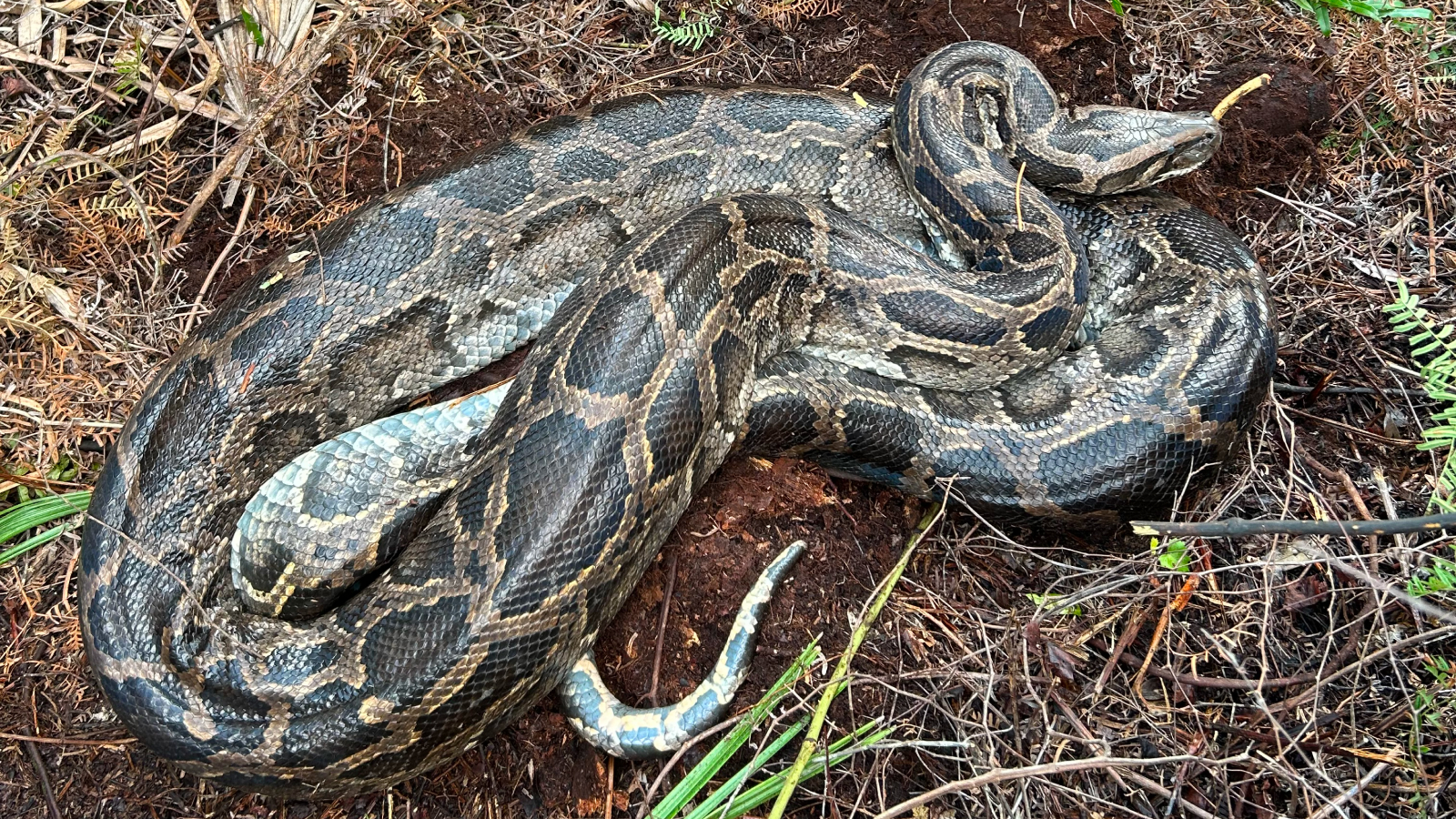By K.r. Callaway
Copyright livescience

Skip to main content
Close main menu
Live Science
Sign up to our newsletter
View Profile
Search Live Science
Planet Earth
Archaeology
Physics & Math
Human Behavior
Science news
Life’s Little Mysteries
Science quizzes
Newsletters
Story archive
Lab brains could become conscious
Skyscraper-sized asteroid flyby
Mysterious hand positions on Maya alter
It’s too late to stop AI, readers say
Anthropologist Ella Al-Shamahi on human origins
Don’t miss these
Scientists discover Burmese pythons have never-before-seen cells that help them digest entire skeletons
Texas puma genes rescue Florida panthers from extinction — for now
Extinct species
Bite marks reveal giant terror birds were potentially prey for another apex predator — humongous caiman
Hiker picks up venomous snake, dies after bite triggers rare allergic reaction, authorities say
Scientists find baby pterosaurs died in violent Jurassic storm 150 million years ago
Land Mammals
Virginia opossums: The American marsupials that have barely changed since the time of the dinosaurs
Planet Earth
Scientists discover changes to the polar vortex that are plunging parts of US into deep freeze
Viruses, Infections & Disease
Scientist’s cat helps discover a rare virus — yet again
70 million-year-old hypercarnivore that ate dinosaurs named after Egyptian god
Viruses, Infections & Disease
New viruses identified in bats in China
Creepy new giant insect may be the heaviest ever recorded in Australia
Night lizards survived dinosaur-killing asteroid strike despite living right next to impact site
Land Mammals
Earth’s early primates evolved in the cold — not the tropics
Extinct species
‘Most remarkable’ fossil of Jurassic sea monster from Germany is previously unknown species
Headless chicken monster: The deep sea cucumber with tubular feet for gobbling sediment
Cold snap in Florida made Burmese python puke up a whole deer
K.R. Callaway
19 September 2025
Difficulty digesting large meals may limit where these temperature-sensitive snakes can call home — and that might be a good thing in places where they’re invasive.
When you purchase through links on our site, we may earn an affiliate commission. Here’s how it works.
The Burmese python was forced it to vomit up a white-tailed deer when temperatures in Florida fell to 50 degrees Fahrenheit.
(Image credit: Travis Mangione, U.S. National Park Service)
A Burmese python in Florida’s Big Cypress National Preserve vomited up an entire white-tailed deer after temperatures in South Florida dipped below 50 degrees Fahrenheit (10 degrees Celsius) late last year, well below the cold-blooded creature’s comfortable range.
While pythons are known to vomit their meals in cold laboratory settings, scientists had never caught the elusive snakes doing it in the wild — until now. The unusual observation, made in late November 2024, is described in a study published in July in the journal Ecology and Evolution.
“Almost every day is a surprise,” Mark Sandfoss, senior author of the study and a biologist at the U.S. Geological Survey (USGS), told Live Science. “Pythons are constantly doing things I never imagined, but this is such a beautiful moment where science and basic principles line up with field observations.”
You may like
Scientists discover Burmese pythons have never-before-seen cells that help them digest entire skeletons
Texas puma genes rescue Florida panthers from extinction — for now
Hiker picks up venomous snake, dies after bite triggers rare allergic reaction, authorities say
Burmese pythons (Python bivittatus) have been an invasive species in Florida since the late 1970s. Despite this decades-long presence, they are largely understudied, and there are gaps in knowledge about the snakes’ biology and how they interact with native species, such as deer.
Deer numbers are declining in the preserve, which is concerning because they form an important part of the diet of local predators, like Florida panthers (Puma concolor coryi). To learn more about how often snakes eat deer and how quickly they digest them, scientists at the preserve spent a year tracking the digestion of several large female pythons — those deemed most likely to eat a deer.
One snake under observation had a large lump in its stomach, indicating that it had eaten something deer-sized. Over the next several days, though, this lump did not appear to get any smaller.
One week after first being observed with a large food bolus, a Burmese python rests in water, still working to digest the meal. (Image credit: Travis Mangione, U.S. National Park Service)
After a cold night, when temperatures dipped to 48.9 F (9.4 C) in the preserve, scientists revisited the snake. They found it lump-free, swimming in the shallow water of a willow swamp near a minimally digested white-tailed deer (Odocoileus virginianus) that it had vomited up.
Sign up for the Live Science daily newsletter now
Get the world’s most fascinating discoveries delivered straight to your inbox.
Contact me with news and offers from other Future brandsReceive email from us on behalf of our trusted partners or sponsorsBy submitting your information you agree to the Terms & Conditions and Privacy Policy and are aged 16 or over.
Related: Scientists discover Burmese pythons have never-before-seen cells that help them digest entire skeletons
“They found her very empty, and they were able to smell a deer not far away and put two and two together,” Sandfoss said.
The 2.5-year-old, 61-pound (28 kilograms) white-tailed deer was minimally digested even after spending about 10 days inside the snake. (Image credit: Travis Mangione, U.S. National Park Service)
Because snakes are cold-blooded, or ectothermic, they find it difficult to function in the cold. Their biological processes, including digestion, slow down until the temperature warms back up.
You may like
Scientists discover Burmese pythons have never-before-seen cells that help them digest entire skeletons
Texas puma genes rescue Florida panthers from extinction — for now
Hiker picks up venomous snake, dies after bite triggers rare allergic reaction, authorities say
If the outdoor temperature gets too cold, a snake’s meal can start decomposing in its stomach faster than the snake can digest it, causing bacteria to build up. The snake’s response is to vomit to eliminate the bacteria. This can be an energy-intensive activity for an already hungry snake, but the snake in the study survived it.
Because the Burmese python is an invasive species in Florida, the snake’s survival has complex implications, Sandfoss said. It missed one of the large meals it takes only a few times a year, so it might lack the energy to reproduce, which could help control the python population. Alternatively, the snake may kill another deer to make up the lost energy, further endangering the deer population native predators rely on.
“Deer in Big Cypress have been declining for several years, and we believe pythons to be a factor in that,” lead author Travis Mangione, a biologist at the National Park Service (NPS), told Live Science. “Because this python survived the vomiting event, it will keep eating native wildlife.”
RELATED STORIES
—200-pound ‘monster’ Burmese python finally captured in Florida after 5 men sit on it
—Burmese python eats even bigger reticulated python alive, in 1st-of-its-kind encounter
—’Truly primal’: Watch Burmese python swallow deer whole in Florida Everglades by stretching its mouth to the absolute limit
Even as scientists work to understand how Burmese pythons’ vomiting events affect the local ecosystem, observations of it in the wild hold valuable clues to how far this invasive species can spread within the United States. Temperature is a key limiting factor for the snakes’ range, and the coldest temperature they can survive might be the coldest in which they can digest, Sandfoss said.
The new study fits within a larger, not-yet-released research project that’s analyzing the full year of python feeding data. The scientists working on the project hope it will shed light on the basic biological process of digestion in Burmese pythons, which is still under-researched.
“Pythons have complicated biology, and we’ve never really dealt with an animal like this at this scale — this large, invasive ectotherm, terrestrial,” Sandfoss said. “We’re trying to figure all these things out.”
Snake quiz: How much do you know about the slithering reptiles?
K.R. Callaway
Live Science Contributor
K.R. Callaway is a freelance journalist specializing in science, health, history and policy. She holds a bachelor’s degree in Classics from the University of Virginia and is a current master’s student in New York University’s Science, Health & Environmental Reporting Program.
You must confirm your public display name before commenting
Please logout and then login again, you will then be prompted to enter your display name.
Scientists discover Burmese pythons have never-before-seen cells that help them digest entire skeletons
Texas puma genes rescue Florida panthers from extinction — for now
Bite marks reveal giant terror birds were potentially prey for another apex predator — humongous caiman
Hiker picks up venomous snake, dies after bite triggers rare allergic reaction, authorities say
Scientists find baby pterosaurs died in violent Jurassic storm 150 million years ago
Virginia opossums: The American marsupials that have barely changed since the time of the dinosaurs
Latest in Snakes
Scientists discover Burmese pythons have never-before-seen cells that help them digest entire skeletons
Florida bobcat bites the head off of 13-foot Burmese python in the Everglades
‘An up-tempo version of Darwinian evolution’: How a mega freeze in Florida may have caused Burmese pythons to evolve at a blindingly fast speed
Snake quiz: Let’s ssseee what you know about these slithering reptiles
Why do snakes shed their skin?
Venomous snake with 3 fangs may be the ‘most dangerous death adder in the world’
Latest in News
Vast source of rare Earth metal niobium was dragged to the surface when a supercontinent tore apart
Cold snap in Florida made Burmese python puke up a whole deer
Skywatching alert! See 2 bright comets on the same night as a meteor shower this October
Saturn will be at its biggest and brightest on Sept. 21 — here’s how to see it
First-ever black hole to be directly imaged has changed ‘dramatically’ in just 4 years, new study finds
CDC committee votes to change measles vaccine guidance for young children
LATEST ARTICLES
Vast source of rare Earth metal niobium was dragged to the surface when a supercontinent tore apart
Farewell to the computer mouse? Bizarre new designs could reduce wrist injuries, scientists say.
Saturn will be at its biggest and brightest on Sept. 21 — here’s how to see it
Skywatching alert! See 2 bright comets on the same night as a meteor shower this October
CDC committee votes to change measles vaccine guidance for young children
Live Science is part of Future US Inc, an international media group and leading digital publisher. Visit our corporate site.
Contact Future’s experts
Terms and conditions
Privacy policy
Cookies policy
Accessibility Statement
Advertise with us
Web notifications
Editorial standards
How to pitch a story to us
Future US, Inc. Full 7th Floor, 130 West 42nd Street,
Please login or signup to comment
Please wait…



